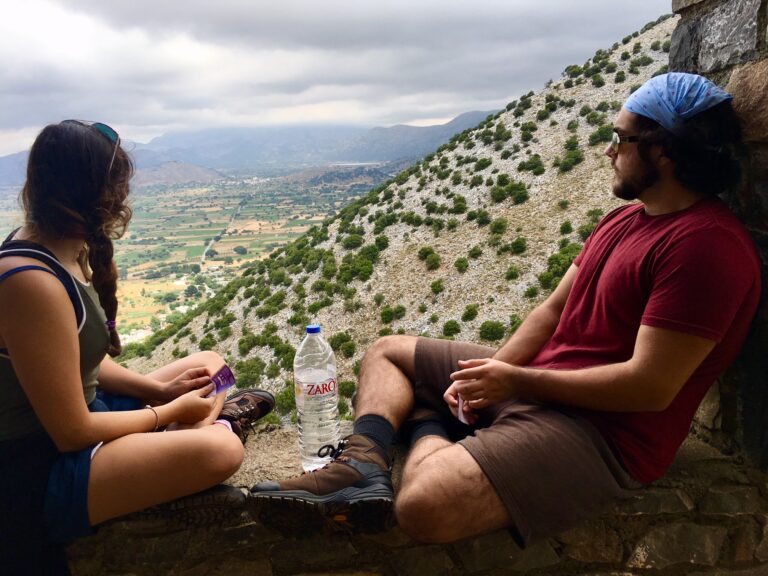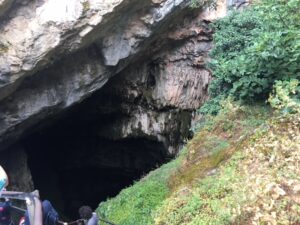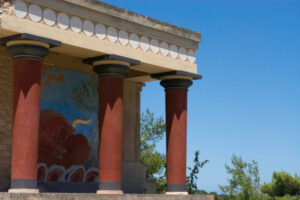I don’t know if you know what it’s like to be raised on a myth, but I’ll try to explain it to you.
Imagine growing up on stories like they were your bread and butter. I suppose that isn’t so unusual, plenty of children grow up in this fashion. Their parents spin them yarns for a tapestry so vast and old that no one can quite pinpoint where the first thread started. They’re a vast web of tales and folklore that, when woven together, make up the fabric of a reality. Not actual reality mind you, but a kind of reality. The whole world takes on a sort of shine, because when you’re raised on tales you end up believing in magic, and when that happens you’re never sure how much is real and how much is make-believe. Kernels of truth exist in myth, after all. And all that makes you wonder if your place in this world fits perfectly in between the truth and the story.
This was all a rather longwinded way to say that the cave Zeus was born in is a real place you can actually visit. You know Zeus; king of the Greek gods, lover of thunderbolts, and the man who set the philandering bar at its high, (or low, depending on your views on philandering). His birthplace, the cave at Lassithi, is a real place that thousands of tourists flock to every year. It was the place his mother Rhea fled to, to hide the existence of her youngest son so he would not be devoured alive by his father, Cronos.
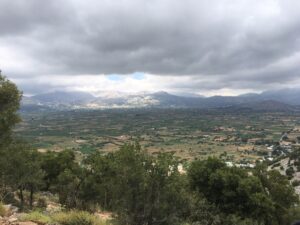
Zeus’s cave is an hour or so drive into the center of the island of Crete. It’s a good drive, a grand way to appreciate the island in all its splendor. There’s nothing quite like turning a corner on a winding mountain road, or seeing a patch of sun drift across the valley in the center of the Lassithi plateau. It’s picturesque, like something out of a storybook. Perhaps a little on the nose, considering I’m selling you on visiting a place rooted in mythology, but it really is quite something to see in person. The last turn you take is a short uphill drive to the parking lot, where little tavernas welcome you with nourishment and a gorgeous overlook. The path to the cave lies across from them, where under an olive grove a small group of donkeys stand around, somehow managing to look both adorable and more than a little treacherous at the same time, as donkeys often do. Music from the tavernas drifts through the trees and dances on the wind as you turn to start the climb.
That’s right. The climb.
“But isn’t this a trip to a cave?” You might be saying. “Isn’t this supposed to be a little hole in the wall? You—you tricked me into hiking!”
Yes, that’s right: I tricked you into hiking. I tricked you into climbing a mountain on your summer vacation. I tricked you into exercising. I would be lying if I didn’t take a sort of perverse pleasure in it. I too was fooled by picture books depicting Zeus’ mother Rhea nursing her child in a cave that was ground level. However, in misleading you I have broken that sacred trust between blogger and reader of said travel blog, and I am sorry. Let me rebuild that trust.
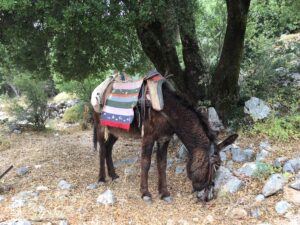
I’ll be honest with you, this climb takes a lot out of you, especially if you’re out of shape like I am. There are two paths to take, the paved ‘easier’ path and an unpaved, wild, untamed path that, if you’re craving an authentic hiking experience to mirror what it was like to climb this mountain a thousand years ago, is perfect for you. If you’re like me, a casual walker at best who just owns a decent pair of sneakers, a water bottle, and some plucky optimism, go with the paved pathway.
The path is steep but not unbearably so. Every so often you find yourself turning around to look back over your shoulder to see just how far you’ve come, which is reassuring as the view really is spectacular. If you can plan your daytrip around a partly cloudy day, do it; the way the sunlight filters through in patches across the valley is so beautiful, it can fill even the most inexperienced hiker with optimism and wonder. Hold that feeling. Carry it in your heart and treasure it as your calf muscles start to seize on you. Try and make it sustain you as you come to realize what those donkeys at the bottom were for, as the little kids riding them up the mountain point their stubby fingers at you in mockery. But don’t glare at them for too long: those donkeys are loaded, shall we say, and they do leave ‘gifts’ along the path. Try and avoid them.
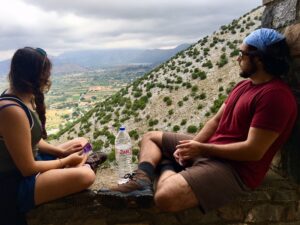
It’s an incredible feeling to reach the top of this path, however. You’re rewarded with a sense of pride, something those brats on the donkeys know nothing about. You worked for this view, you earned it. Bask in your sense of superiority. It’s good to reflect on our accomplishments. In fact, the top of the mountain is the perfect place to celebrate them; someone had the absolutely brilliant idea of building a small taverna at the top, which serves fresh juice and water to the poor dehydrated visitors.
“So now, I’ve reached the top. A quick peak into the tiny cave and I walk casually back down the mountain. Right? …Right?”
I’ve misled you again. I keep doing that. I really do need to work on our trust exercises, I’m aware.
After paying a small entrance fee, (hope you brought some cash to get past this point Dad, or else you’re trekking back down that mountain to the car and up again all by yourself), you turn a small corner and see a hint of the cave entrance. The hole may not seem that large at first, but as you approach it widens, like the mouth of a monster opening to receive the offering of tourists. It is a gaping maw, a black abyss into the side of the mountain, with steps that descend into the very bowels of the earth. This is why they call it the ‘mouth’ of the cave, you think, as you commit yourself as one of thousands who step willingly onto the tongue. It may seem slightly dangerous, and I’d be lying if this part of the trip didn’t require a bit of caution. It does. The stairs are metal, and the farther you descend into the cave, the more saturated with moisture they become. Hold tight to the (albeit slippery) railing, follow the signs for which set of stairs to keep to, and you’ll be just fine. It’s pretty surreal to see, hordes and hordes of people filing down into the earth, and you have to wonder if the scene before you mirrors a descent into Hades rather than the place a baby once lived in. The cave screams “underworld” more than “nursery,” but I suppose you can’t be too picky when avoiding your father who wants to eat you.
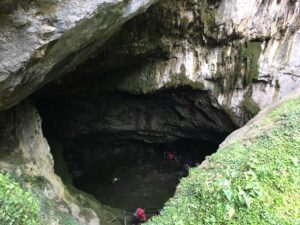
The hot and humid summer air has no influence here, in fact it makes you wonder why you didn’t think to pack a sweater. Lights illuminate the rock formations on the ceilings and the walls, and small pools of water glisten in the darkness, and you know for sure that though they look quite shallow, they’re probably fathoms deep. Look closer at the walls around you. Are those faces, ghosts of legends imprisoned in the cave wall? Or just your eyes playing tricks on you? Echoes bounce around, and you wonder if that faint cry is the ghost of a memory of the infant Zeus, as the shushing of an anxious mother quiets it out of fear and love. The air is somehow thinner here. Maybe you’ve slipped between the cracks, between times, and maybe you’ll turn the corner to find them sitting there in the darkness, perched on a rock. It’s exciting and unsettling all at once.
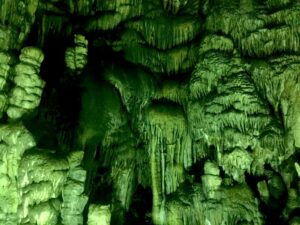
Only a small orb of light makes it down from the entrance, but it’s a light you’re drawn to as you circle around and make your way. Gripping the railing tightly, you follow the procession of visitors who make the slow climb back into the day. If you’re like me, you’ll probably blink a little in confusion, turn around, and stare again at the mouth of the cave. Were you ever down there at all, in that inky blackness? Did you transition from reality to myth and back again? You check your phone for the photos of the rock formations. They’re there. Boy, are they going to make some killer Instagram pics later…perhaps you were down there after all. But now it’s time for another fruit juice. Banish these thoughts from you, of blurred lines and jumbled myths: sip something cold, gaze at the view, take a deep breath, and get the group together. It’s time to go.
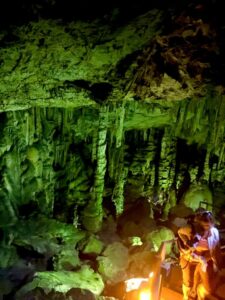
If you get the chance, when you’ve returned to your villa, gaze out over the pool. There’s a mountain range there that looks almost like the profile of a grizzled man, cut from the stone, his eyes closed. That’s Zeus, come to rest on the island of his birth, taking refuge in death at the same place he found safety in birth. I’m not yanking your chain, he’s there, sleeping and covered in grass and trees and goats and Cretans, and of course, you. They let him sleep though, the Cretans…his dreams keep the island the magical place that it is, a blend of myth and reality, a place where the lines between the two are blurred. And you know firsthand the power of that blur now.
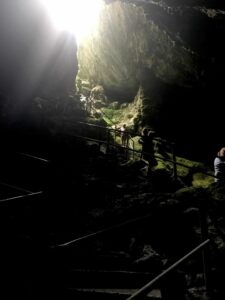
By Katarina Kapetanakis

